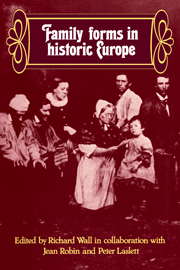Book contents
- Frontmatter
- Contents
- List of contributors
- Preface
- 1 Introduction
- 2 Two kinds of pre-industrial household formation system
- 3 ‘A large family: the peasant's greatest wealth’: serf households in Mishino, Russia, 1814–1858
- 4 The peasant family as an economic unit in the Polish feudal economy of the eighteenth century
- 5 The familial contexts of early childhood in Baltic serf society
- 6 Estonian households in the seventeenth and eighteenth centuries
- 7 Family and familia in early-medieval Bavaria
- 8 The property and kin relationships of retired farmers in northern and central Europe
- 9 Pre-industrial household structure in Hungary
- 10 The reconstruction of the family life course: theoretical problems and empirical results
- 11 The changing household: Austrian household structure from the seventeenth to the early twentieth century
- 12 Does owning real property influence the form of the household? An example from rural West Flanders
- 13 The evolving household: the case of Lampernisse, West Flanders
- 14 The composition of households in a population of 6 men to 10 women: south-east Bruges in 1814
- 15 The importance of women in an urban environment: the example of the Rheims household at the beginning of the Industrial Revolution
- 16 The household: demographic and economic change in England, 1650–1970
- 17 Family and household as work group and kin group: areas of traditional Europe compared
- References
- Index
4 - The peasant family as an economic unit in the Polish feudal economy of the eighteenth century
Published online by Cambridge University Press: 05 November 2011
- Frontmatter
- Contents
- List of contributors
- Preface
- 1 Introduction
- 2 Two kinds of pre-industrial household formation system
- 3 ‘A large family: the peasant's greatest wealth’: serf households in Mishino, Russia, 1814–1858
- 4 The peasant family as an economic unit in the Polish feudal economy of the eighteenth century
- 5 The familial contexts of early childhood in Baltic serf society
- 6 Estonian households in the seventeenth and eighteenth centuries
- 7 Family and familia in early-medieval Bavaria
- 8 The property and kin relationships of retired farmers in northern and central Europe
- 9 Pre-industrial household structure in Hungary
- 10 The reconstruction of the family life course: theoretical problems and empirical results
- 11 The changing household: Austrian household structure from the seventeenth to the early twentieth century
- 12 Does owning real property influence the form of the household? An example from rural West Flanders
- 13 The evolving household: the case of Lampernisse, West Flanders
- 14 The composition of households in a population of 6 men to 10 women: south-east Bruges in 1814
- 15 The importance of women in an urban environment: the example of the Rheims household at the beginning of the Industrial Revolution
- 16 The household: demographic and economic change in England, 1650–1970
- 17 Family and household as work group and kin group: areas of traditional Europe compared
- References
- Index
Summary
The interaction of economic and demographic factors in peasant family life
The Polish economy of the eighteenth century was basically agrarian, the peasant family farm being the dominant unit of production. However, we have only a limited knowledge of its functions. Earlier studies have concentrated on those aspects which can be most easily found in the sources, that is the distribution of land among the villagers, the obligations connected with the holding of land, the size of holdings, and the amount of production, though this was usually confined to the production of corn. In general, we can say that we know more about the material aspects of peasant life than about the economic ones. We know little about economic and financial decisions made by peasants and about their responses to economic change, such as fluctuations in the size of the harvest and in prices. In particular, we have little knowledge of the connection between the economic and demographic aspects of peasant life. That connection must have been important, first, because the family constituted the main source of labour for a peasant farm and, second, because family members were the principal recipients of peasant farm products. We are well aware that the size and structure of any family is subject to change. Both the number of people to feed and the number of people who can work change during the family life cycle.
- Type
- Chapter
- Information
- Family Forms in Historic Europe , pp. 153 - 166Publisher: Cambridge University PressPrint publication year: 1983
- 5
- Cited by



